人教课标必修一Unit3Unit 3 Travel journal P2 Reading(共43张PPT)
文档属性
| 名称 | 人教课标必修一Unit3Unit 3 Travel journal P2 Reading(共43张PPT) |  | |
| 格式 | zip | ||
| 文件大小 | 6.8MB | ||
| 资源类型 | 教案 | ||
| 版本资源 | 人教版(新课程标准) | ||
| 科目 | 英语 | ||
| 更新时间 | 2015-02-12 22:07:18 | ||
图片预览

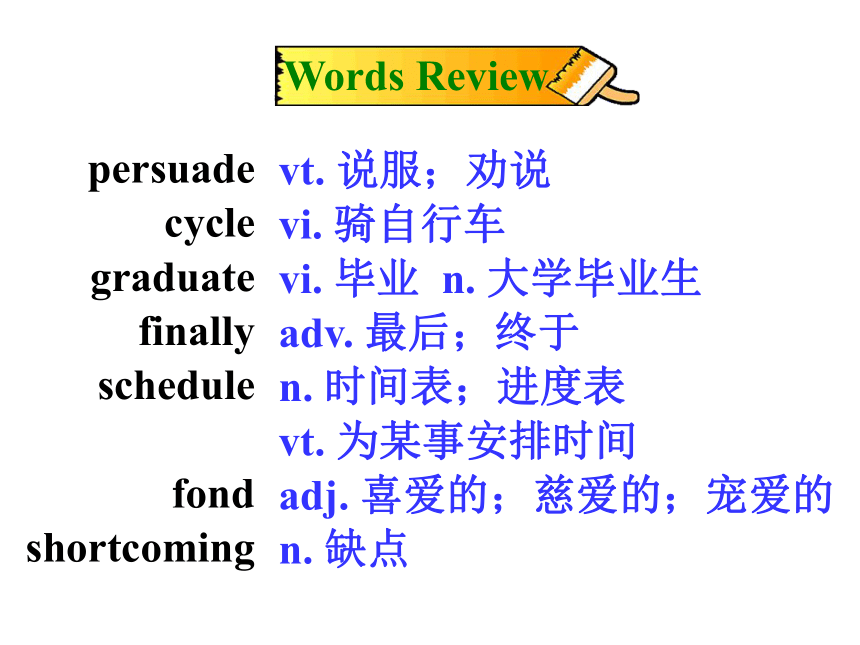
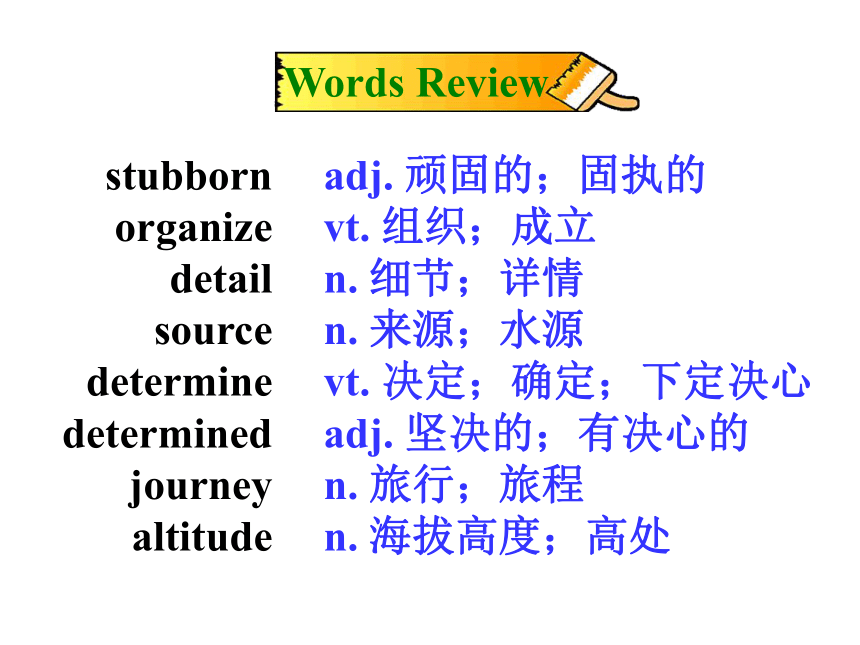
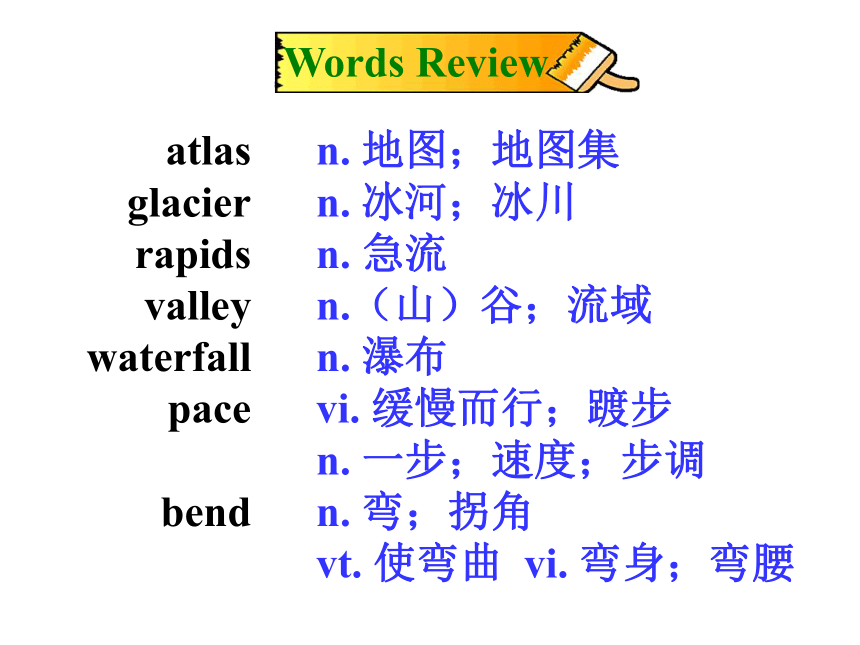



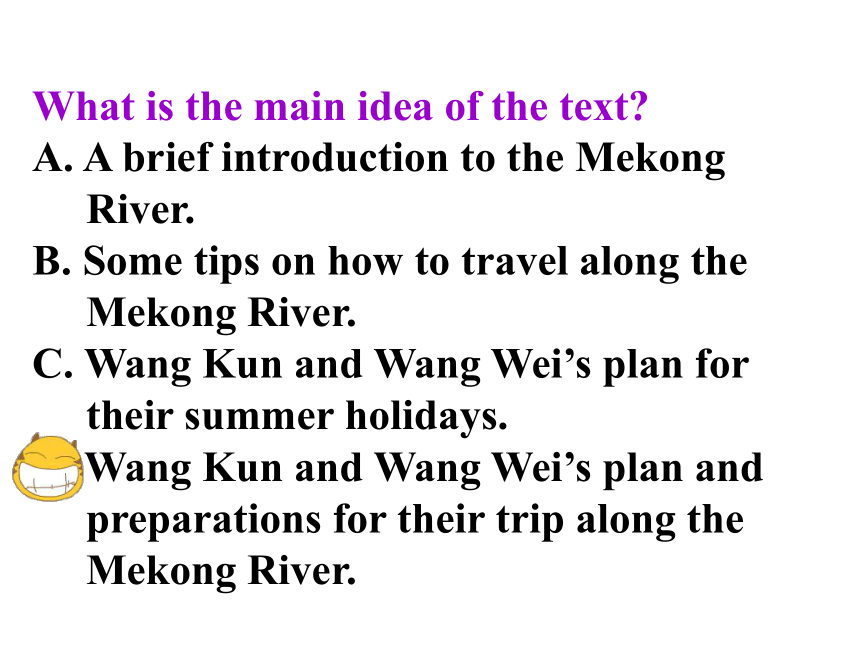
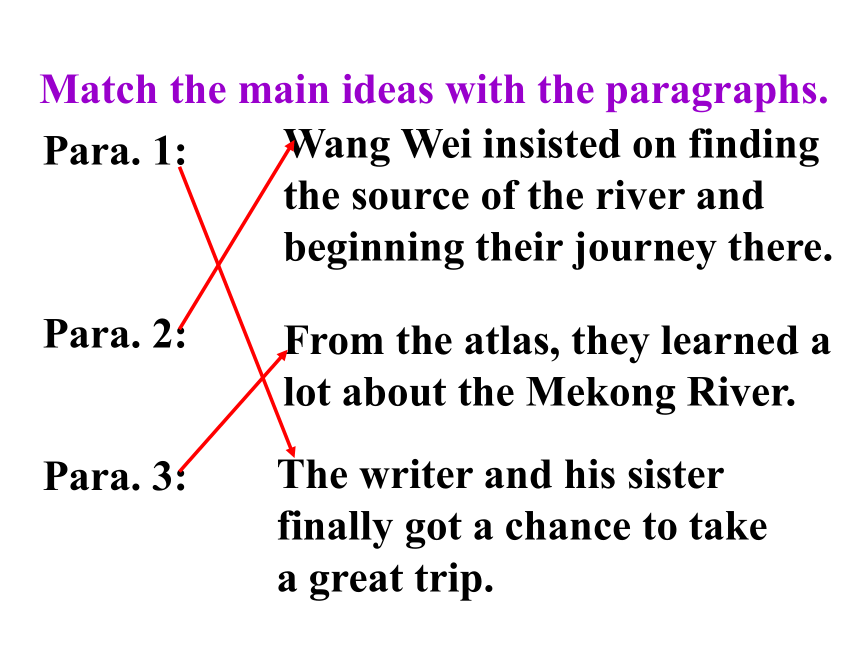

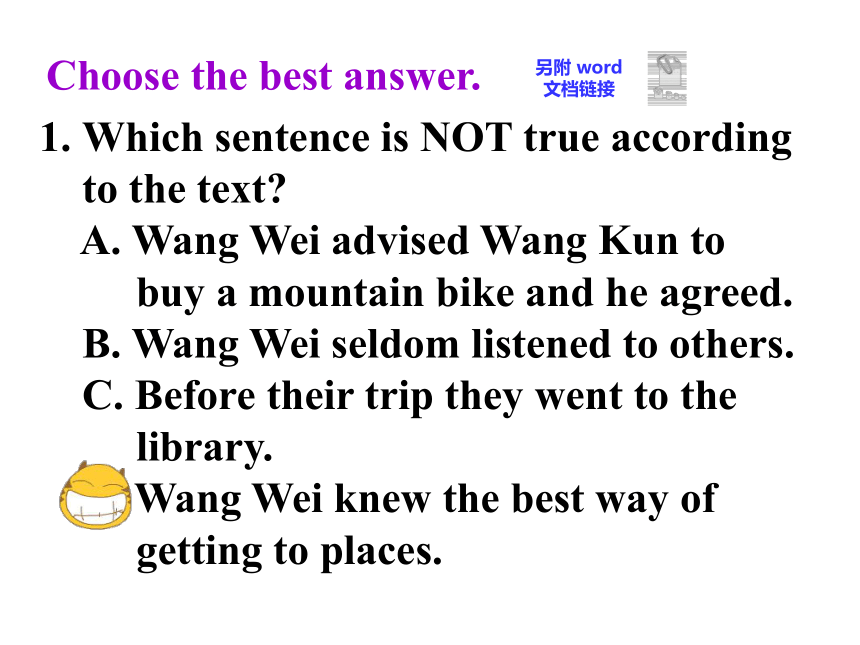

文档简介
课件43张PPT。Unit 3JOURNEY DOWN THE MEKONGWords Reviewpersuade
cycle
graduate
finally
schedule
fond
shortcomingvt. 说服;劝说
vi. 骑自行车
vi. 毕业 n. 大学毕业生
adv. 最后;终于
n. 时间表;进度表
vt. 为某事安排时间
adj. 喜爱的;慈爱的;宠爱的
n. 缺点Words Reviewstubborn
organize
detail
source
determine
determined
journey
altitudeadj. 顽固的;固执的
vt. 组织;成立
n. 细节;详情
n. 来源;水源
vt. 决定;确定;下定决心
adj. 坚决的;有决心的
n. 旅行;旅程
n. 海拔高度;高处Words Reviewatlas
glacier
rapids
valley
waterfall
pace
bendn. 地图;地图集
n. 冰河;冰川
n. 急流
n.(山)谷;流域
n. 瀑布
vi. 缓慢而行;踱步
n. 一步;速度;步调
n. 弯;拐角
vt. 使弯曲 vi. 弯身;弯腰ever since
be fond of
care about
change one’s mind
make up one’s mind
give in改变主意
下决心; 决定
投降; 屈服; 让步
照顾; 照看
从那以后
喜爱; 喜欢
关心; 忧虑; 惦念Match1. To summarize and remember the
main idea of the passage — Journey
down the Mekong.
2. To understand Wang Wei’s and Wang
Kun’s attitude to the trip.
3. To know more about the Mekong River.Skimming for general ideaWhat is the main idea of the text?
A. A brief introduction to the Mekong
River.
B. Some tips on how to travel along the
Mekong River.
C. Wang Kun and Wang Wei’s plan for
their summer holidays.
D. Wang Kun and Wang Wei’s plan and
preparations for their trip along the
Mekong River. Wang Wei insisted on finding the source of the river and beginning their journey there.From the atlas, they learned a lot about the Mekong River.Para. 1:Para. 2:Para. 3:The writer and his sister finally got a chance to take a great trip.Match the main ideas with the paragraphs. Scanning for specific informationWhich sentence is NOT true according
to the text?
A. Wang Wei advised Wang Kun to
buy a mountain bike and he agreed.
B. Wang Wei seldom listened to others.
C. Before their trip they went to the
library.
D. Wang Wei knew the best way of
getting to places.Choose the best answer.另附 word 文档链接2. When you travel along the Mekong River maybe you can not see _________.
A. waterfalls B. hills and valleys
C. plains where rice grows D. desert
3. How will Wang Kun and Wang Wei travel
along the Mekong River?
A. On foot. B. By car.
C. By bicycle. D. By ship.4. Which word can’t be used to describe Wang Wei?
A. Determined. B. Careful.
C. Stubborn. D. Risk-taking.
5. How did they get the information they needed?
A. Surfing the Internet.
B. Asking their teacher for help.
C. Going to the library.
D. Asking the travel agent for help. Wang Wei insisted that they begin the
journey in Qinghai.
2. When they arrived in Tibet, it was
winter then.
3. The journey would begin at an altitude of more than 5000 meters, where it is hard to breathe and very cold. True or false4. They couldn’t find any information about the Mekong River in the library.
5. The Mekong river begins in a glacier on
a Tibetan mountain, the water there is
clear and warm.
6. The river delta enters the South
China Sea. 1. What can you see when you travel
along the Mekong?
2. What difficulties did Wang Kun and Wang Wei find about their journey?
3. What do you think about Wang Kun and Wang Wei?Answer the questions below.1. What can you see when you travel
along the Mekong? You can see the source glacier,
rapids, hills, valleys, waterfalls
and plains.glacierwaterfallplainvalleyrapidshill2. What difficulties did Wang Kun
and Wang Wei find about their
journey? The journey will begin at an altitude
of more than 5,000 metres, where it
is hard to breathe and very cold.3. What do you think about Wang Kun and Wang Wei?Wang Kun’s character:Wang Wei’s character: enthusiastic, critical, sensibleimaginative, organized, eager,
persistent, stubborn, risk-takingAttitudes about the tripSimilar attitudes about the tripBoth Wang Wei and Wang Kun think
taking this trip is a dream that
comes true.
2. they will enjoy the trip a lot.
3. they should see a lot of the Mekong.Different attitudes about the tripWang Wei believes
they must start in Qinghai where the
river begins/see all of the Mekong.
2. that they don’t need to prepare much.
Wang Kun believes
1. it is too cold and high to start in Qinghai.
2. that using an atlas is very important.Careful reading重难点句式分析1. They are Dai and grew up in western
Yunnan Province near the Lancang River,
the Chinese part of the river that is called
the Mekong River in other countries.
生长,长大成人地点状语定语同位语定语从句他们是傣族人,在云南省西部靠近澜沧江的地方生长,湄公河在中国境内的这一段
叫澜沧江,在其他国家境内叫湄公河。1. 她在东京长大。
She grew up in Tokyo.3. 我住在一个名叫郝家川的小山村。
I live in a village that is called Haojiachuan. Practice2. 我更喜欢读爸爸买的那本书。
I prefer to read the book that was bought by my father. 2. It was my sister who first had the idea to cycle along the entire Mekong River from where it begins to where it ends.
It was ... who / that ... 强调句式。
用来强调句子里除谓语外的各种成分,以引起听者或读者的注意。
强调句的判断方法:一般来说,如果将it is/was ... 与连接词去掉,句子仍然正确,就为强调句型。 首先想到要沿湄公河从源头到终点骑车旅行的是我的姐姐。定语状语宾语从句宾语从句1. 认为汤姆是个聪明男孩的是史密斯先生。
It is Mr Smith who thinks Tom is a clever boy.3. 从这里到那里仅有两百米远。
It’s only two hundred metres from here to there.Practice2. 昨天是约翰把钥匙丢在这儿了。
It was John who left the key here yesterday.ParaphraseLook at the following sentences and explain them in your own words.1. She gave me a determined look — the kind
that said that she would not change her
mind.
She has decided to do something and will
not change her ideas.
2. It makes wide bends or meanders through
low valleys to the plains where rice grows.
The Mekong River flows slowly and gently
through the valleys and reaches the
farming plains.Discuss the question in groups. Imagine that in the morning there is a dialogue between Wang Kun and Wang Wei. What do you think they would say before they leave camp?Tips: 1. Wang Kun looked tired …2. Wang Wei had a dream …3. They talked about the weather/
beauty of the mountains … Group discussionNow two minutes to test your spelling.Spelling Bee1. English-Chinese
schedule, shortcoming, journey, altitude,
valley, pace
2. Chinese-English
说服,毕业,最后,喜爱的,骑自行车,
弯身,组织,决定,坚决的,顽固的When finished, exchange your papers to see who does the best.I. Complete the passage with proper words, which will help you retell the text.另附 word 文档链接Ever since middle school, my sister Wang
Wei and I ______________ (dream) of taking a bike trip. Two years ago, she bought an expensive bike and persuaded ____ to buy one. It was my sister ________ first had the idea to cycle along the Mekong River. After ___________ (graduate) from college, we got the chance to take a bike trip. have dreamedmewho/thatgraduating_________ she didn’t know the best way to get places, she insisted that she be the _________ (organize) of the whole trip. ____ a stubborn girl, once she has made up her mind, nothing can change it. When I told her that our journey would begin at an altitude of more than 5,000 metres, she seemed to be excited to take a trip which she thought would be _______________ (interesting) than those she had ever had.AlthoughorganizerAsmore interestingBefore our trip, we went to the library to find some maps ______ showed details of world geography. From the maps, we could see that the Mekong River begins in ____ glacier on a Tibetan mountain. It becomes rapids as it passes through valleys, and finally
it enters the South China Sea.thataII. Task-based reading.Match the following words with their right meanings.1. leftover __________
2. annual __________
3. honoree __________
a. someone who receives an honor
b. remaining after all the rest has been
used
c. happening once a yearacb另附 word 文档链接Self-assessmentThink about what we’ve just learnt today.Time for Reflection Study without reflection is a waste of time.Think in English After the classIt’s time to stop the class for us to look back in silence.Write a travel journal in about
100 words.ever since, persuade, cycle, be fond of, shortcoming, determine, altitude, give in, valley, pace.2. 发挥想象,连词成文(50-100字)。Homework3. Read the articles in page 1 of Learning English. The more you read, the faster and better you’ll understand. When finished reading, write a summary in 100 words or so.
4. Read the following passage and
copy it into your notebook. Pay
attention to the coloured words.Almost every machine with moving parts has wheels, yet no one knows exactly when the first wheel was invented or what it was used for. We do know, however, that they existed over 5,500 years ago in ancient Asia.
The oldest known transport wheel was discovered in 2002 in Slovenia. It is over 5,100 years old. Evidence suggests that wheels for transport didn't become popular for a while, though. This could be because animals did a perfectly good job of carrying farming tools and humans around.
But it could also be because of a difficult situation. While wheels need to roll on smooth surfaces, roads with smooth surfaces weren't going to be constructed until there was plenty of demand for them. Eventually, road surfaces did become smoother, but this difficult situation appeared again a few centuries later. There had been no important changes in wheel and vehicle design before the arrival of modem road design.
In the mid-1700s, a Frenchman came up with a new design of road — a base layer (层) of large stones covered with a thin layer of smaller stones. A Scotsman improved on this design in the 1820s and a strong, lasting road surface became a reality. At around the same lime, metal hubs (the central part of a wheel) came into being, followed by the pneumatic tyre (充气轮胎) in 1846. Alloy wheels were invented in 1967, sixty years after the appearance of tarmacked roads (柏油路). As wheel design took off, vehicles got faster and faster.
cycle
graduate
finally
schedule
fond
shortcomingvt. 说服;劝说
vi. 骑自行车
vi. 毕业 n. 大学毕业生
adv. 最后;终于
n. 时间表;进度表
vt. 为某事安排时间
adj. 喜爱的;慈爱的;宠爱的
n. 缺点Words Reviewstubborn
organize
detail
source
determine
determined
journey
altitudeadj. 顽固的;固执的
vt. 组织;成立
n. 细节;详情
n. 来源;水源
vt. 决定;确定;下定决心
adj. 坚决的;有决心的
n. 旅行;旅程
n. 海拔高度;高处Words Reviewatlas
glacier
rapids
valley
waterfall
pace
bendn. 地图;地图集
n. 冰河;冰川
n. 急流
n.(山)谷;流域
n. 瀑布
vi. 缓慢而行;踱步
n. 一步;速度;步调
n. 弯;拐角
vt. 使弯曲 vi. 弯身;弯腰ever since
be fond of
care about
change one’s mind
make up one’s mind
give in改变主意
下决心; 决定
投降; 屈服; 让步
照顾; 照看
从那以后
喜爱; 喜欢
关心; 忧虑; 惦念Match1. To summarize and remember the
main idea of the passage — Journey
down the Mekong.
2. To understand Wang Wei’s and Wang
Kun’s attitude to the trip.
3. To know more about the Mekong River.Skimming for general ideaWhat is the main idea of the text?
A. A brief introduction to the Mekong
River.
B. Some tips on how to travel along the
Mekong River.
C. Wang Kun and Wang Wei’s plan for
their summer holidays.
D. Wang Kun and Wang Wei’s plan and
preparations for their trip along the
Mekong River. Wang Wei insisted on finding the source of the river and beginning their journey there.From the atlas, they learned a lot about the Mekong River.Para. 1:Para. 2:Para. 3:The writer and his sister finally got a chance to take a great trip.Match the main ideas with the paragraphs. Scanning for specific informationWhich sentence is NOT true according
to the text?
A. Wang Wei advised Wang Kun to
buy a mountain bike and he agreed.
B. Wang Wei seldom listened to others.
C. Before their trip they went to the
library.
D. Wang Wei knew the best way of
getting to places.Choose the best answer.另附 word 文档链接2. When you travel along the Mekong River maybe you can not see _________.
A. waterfalls B. hills and valleys
C. plains where rice grows D. desert
3. How will Wang Kun and Wang Wei travel
along the Mekong River?
A. On foot. B. By car.
C. By bicycle. D. By ship.4. Which word can’t be used to describe Wang Wei?
A. Determined. B. Careful.
C. Stubborn. D. Risk-taking.
5. How did they get the information they needed?
A. Surfing the Internet.
B. Asking their teacher for help.
C. Going to the library.
D. Asking the travel agent for help. Wang Wei insisted that they begin the
journey in Qinghai.
2. When they arrived in Tibet, it was
winter then.
3. The journey would begin at an altitude of more than 5000 meters, where it is hard to breathe and very cold. True or false4. They couldn’t find any information about the Mekong River in the library.
5. The Mekong river begins in a glacier on
a Tibetan mountain, the water there is
clear and warm.
6. The river delta enters the South
China Sea. 1. What can you see when you travel
along the Mekong?
2. What difficulties did Wang Kun and Wang Wei find about their journey?
3. What do you think about Wang Kun and Wang Wei?Answer the questions below.1. What can you see when you travel
along the Mekong? You can see the source glacier,
rapids, hills, valleys, waterfalls
and plains.glacierwaterfallplainvalleyrapidshill2. What difficulties did Wang Kun
and Wang Wei find about their
journey? The journey will begin at an altitude
of more than 5,000 metres, where it
is hard to breathe and very cold.3. What do you think about Wang Kun and Wang Wei?Wang Kun’s character:Wang Wei’s character: enthusiastic, critical, sensibleimaginative, organized, eager,
persistent, stubborn, risk-takingAttitudes about the tripSimilar attitudes about the tripBoth Wang Wei and Wang Kun think
taking this trip is a dream that
comes true.
2. they will enjoy the trip a lot.
3. they should see a lot of the Mekong.Different attitudes about the tripWang Wei believes
they must start in Qinghai where the
river begins/see all of the Mekong.
2. that they don’t need to prepare much.
Wang Kun believes
1. it is too cold and high to start in Qinghai.
2. that using an atlas is very important.Careful reading重难点句式分析1. They are Dai and grew up in western
Yunnan Province near the Lancang River,
the Chinese part of the river that is called
the Mekong River in other countries.
生长,长大成人地点状语定语同位语定语从句他们是傣族人,在云南省西部靠近澜沧江的地方生长,湄公河在中国境内的这一段
叫澜沧江,在其他国家境内叫湄公河。1. 她在东京长大。
She grew up in Tokyo.3. 我住在一个名叫郝家川的小山村。
I live in a village that is called Haojiachuan. Practice2. 我更喜欢读爸爸买的那本书。
I prefer to read the book that was bought by my father. 2. It was my sister who first had the idea to cycle along the entire Mekong River from where it begins to where it ends.
It was ... who / that ... 强调句式。
用来强调句子里除谓语外的各种成分,以引起听者或读者的注意。
强调句的判断方法:一般来说,如果将it is/was ... 与连接词去掉,句子仍然正确,就为强调句型。 首先想到要沿湄公河从源头到终点骑车旅行的是我的姐姐。定语状语宾语从句宾语从句1. 认为汤姆是个聪明男孩的是史密斯先生。
It is Mr Smith who thinks Tom is a clever boy.3. 从这里到那里仅有两百米远。
It’s only two hundred metres from here to there.Practice2. 昨天是约翰把钥匙丢在这儿了。
It was John who left the key here yesterday.ParaphraseLook at the following sentences and explain them in your own words.1. She gave me a determined look — the kind
that said that she would not change her
mind.
She has decided to do something and will
not change her ideas.
2. It makes wide bends or meanders through
low valleys to the plains where rice grows.
The Mekong River flows slowly and gently
through the valleys and reaches the
farming plains.Discuss the question in groups. Imagine that in the morning there is a dialogue between Wang Kun and Wang Wei. What do you think they would say before they leave camp?Tips: 1. Wang Kun looked tired …2. Wang Wei had a dream …3. They talked about the weather/
beauty of the mountains … Group discussionNow two minutes to test your spelling.Spelling Bee1. English-Chinese
schedule, shortcoming, journey, altitude,
valley, pace
2. Chinese-English
说服,毕业,最后,喜爱的,骑自行车,
弯身,组织,决定,坚决的,顽固的When finished, exchange your papers to see who does the best.I. Complete the passage with proper words, which will help you retell the text.另附 word 文档链接Ever since middle school, my sister Wang
Wei and I ______________ (dream) of taking a bike trip. Two years ago, she bought an expensive bike and persuaded ____ to buy one. It was my sister ________ first had the idea to cycle along the Mekong River. After ___________ (graduate) from college, we got the chance to take a bike trip. have dreamedmewho/thatgraduating_________ she didn’t know the best way to get places, she insisted that she be the _________ (organize) of the whole trip. ____ a stubborn girl, once she has made up her mind, nothing can change it. When I told her that our journey would begin at an altitude of more than 5,000 metres, she seemed to be excited to take a trip which she thought would be _______________ (interesting) than those she had ever had.AlthoughorganizerAsmore interestingBefore our trip, we went to the library to find some maps ______ showed details of world geography. From the maps, we could see that the Mekong River begins in ____ glacier on a Tibetan mountain. It becomes rapids as it passes through valleys, and finally
it enters the South China Sea.thataII. Task-based reading.Match the following words with their right meanings.1. leftover __________
2. annual __________
3. honoree __________
a. someone who receives an honor
b. remaining after all the rest has been
used
c. happening once a yearacb另附 word 文档链接Self-assessmentThink about what we’ve just learnt today.Time for Reflection Study without reflection is a waste of time.Think in English After the classIt’s time to stop the class for us to look back in silence.Write a travel journal in about
100 words.ever since, persuade, cycle, be fond of, shortcoming, determine, altitude, give in, valley, pace.2. 发挥想象,连词成文(50-100字)。Homework3. Read the articles in page 1 of Learning English. The more you read, the faster and better you’ll understand. When finished reading, write a summary in 100 words or so.
4. Read the following passage and
copy it into your notebook. Pay
attention to the coloured words.Almost every machine with moving parts has wheels, yet no one knows exactly when the first wheel was invented or what it was used for. We do know, however, that they existed over 5,500 years ago in ancient Asia.
The oldest known transport wheel was discovered in 2002 in Slovenia. It is over 5,100 years old. Evidence suggests that wheels for transport didn't become popular for a while, though. This could be because animals did a perfectly good job of carrying farming tools and humans around.
But it could also be because of a difficult situation. While wheels need to roll on smooth surfaces, roads with smooth surfaces weren't going to be constructed until there was plenty of demand for them. Eventually, road surfaces did become smoother, but this difficult situation appeared again a few centuries later. There had been no important changes in wheel and vehicle design before the arrival of modem road design.
In the mid-1700s, a Frenchman came up with a new design of road — a base layer (层) of large stones covered with a thin layer of smaller stones. A Scotsman improved on this design in the 1820s and a strong, lasting road surface became a reality. At around the same lime, metal hubs (the central part of a wheel) came into being, followed by the pneumatic tyre (充气轮胎) in 1846. Alloy wheels were invented in 1967, sixty years after the appearance of tarmacked roads (柏油路). As wheel design took off, vehicles got faster and faster.
